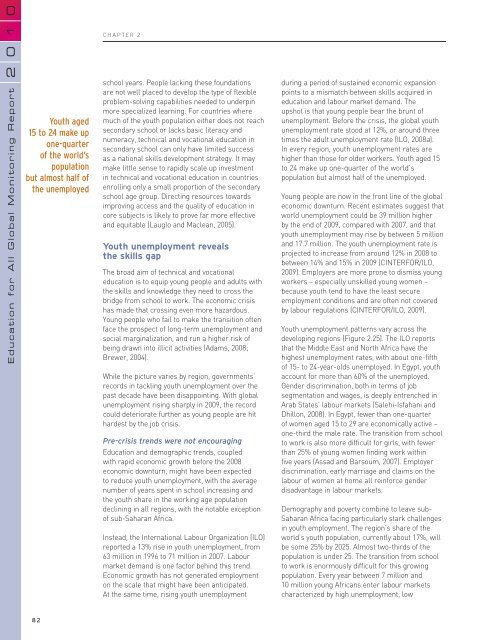Chapter 2. Progress towards the EFA goals - Unesco
Chapter 2. Progress towards the EFA goals - Unesco
Chapter 2. Progress towards the EFA goals - Unesco
You also want an ePaper? Increase the reach of your titles
YUMPU automatically turns print PDFs into web optimized ePapers that Google loves.
0<br />
1<br />
2<br />
0<br />
CHAPTER 2<br />
Education for All Global Monitoring Report<br />
Youth aged<br />
15 to 24 make up<br />
one-quarter<br />
of <strong>the</strong> world’s<br />
population<br />
but almost half of<br />
<strong>the</strong> unemployed<br />
school years. People lacking <strong>the</strong>se foundations<br />
are not well placed to develop <strong>the</strong> type of flexible<br />
problem-solving capabilities needed to underpin<br />
more specialized learning. For countries where<br />
much of <strong>the</strong> youth population ei<strong>the</strong>r does not reach<br />
secondary school or lacks basic literacy and<br />
numeracy, technical and vocational education in<br />
secondary school can only have limited success<br />
as a national skills development strategy. It may<br />
make little sense to rapidly scale up investment<br />
in technical and vocational education in countries<br />
enrolling only a small proportion of <strong>the</strong> secondary<br />
school age group. Directing resources <strong>towards</strong><br />
improving access and <strong>the</strong> quality of education in<br />
core subjects is likely to prove far more effective<br />
and equitable (Lauglo and Maclean, 2005).<br />
Youth unemployment reveals<br />
<strong>the</strong> skills gap<br />
The broad aim of technical and vocational<br />
education is to equip young people and adults with<br />
<strong>the</strong> skills and knowledge <strong>the</strong>y need to cross <strong>the</strong><br />
bridge from school to work. The economic crisis<br />
has made that crossing even more hazardous.<br />
Young people who fail to make <strong>the</strong> transition often<br />
face <strong>the</strong> prospect of long-term unemployment and<br />
social marginalization, and run a higher risk of<br />
being drawn into illicit activities (Adams, 2008;<br />
Brewer, 2004).<br />
While <strong>the</strong> picture varies by region, governments’<br />
records in tackling youth unemployment over <strong>the</strong><br />
past decade have been disappointing. With global<br />
unemployment rising sharply in 2009, <strong>the</strong> record<br />
could deteriorate fur<strong>the</strong>r as young people are hit<br />
hardest by <strong>the</strong> job crisis.<br />
Pre-crisis trends were not encouraging<br />
Education and demographic trends, coupled<br />
with rapid economic growth before <strong>the</strong> 2008<br />
economic downturn, might have been expected<br />
to reduce youth unemployment, with <strong>the</strong> average<br />
number of years spent in school increasing and<br />
<strong>the</strong> youth share in <strong>the</strong> working age population<br />
declining in all regions, with <strong>the</strong> notable exception<br />
of sub-Saharan Africa.<br />
Instead, <strong>the</strong> International Labour Organization (ILO)<br />
reported a 13% rise in youth unemployment, from<br />
63 million in 1996 to 71 million in 2007. Labour<br />
market demand is one factor behind this trend.<br />
Economic growth has not generated employment<br />
on <strong>the</strong> scale that might have been anticipated.<br />
At <strong>the</strong> same time, rising youth unemployment<br />
during a period of sustained economic expansion<br />
points to a mismatch between skills acquired in<br />
education and labour market demand. The<br />
upshot is that young people bear <strong>the</strong> brunt of<br />
unemployment. Before <strong>the</strong> crisis, <strong>the</strong> global youth<br />
unemployment rate stood at 12%, or around three<br />
times <strong>the</strong> adult unemployment rate (ILO, 2008a).<br />
In every region, youth unemployment rates are<br />
higher than those for older workers. Youth aged 15<br />
to 24 make up one-quarter of <strong>the</strong> world’s<br />
population but almost half of <strong>the</strong> unemployed.<br />
Young people are now in <strong>the</strong> front line of <strong>the</strong> global<br />
economic downturn. Recent estimates suggest that<br />
world unemployment could be 39 million higher<br />
by <strong>the</strong> end of 2009, compared with 2007, and that<br />
youth unemployment may rise by between 5 million<br />
and 17.7 million. The youth unemployment rate is<br />
projected to increase from around 12% in 2008 to<br />
between 14% and 15% in 2009 (CINTERFOR/ILO,<br />
2009). Employers are more prone to dismiss young<br />
workers – especially unskilled young women –<br />
because youth tend to have <strong>the</strong> least secure<br />
employment conditions and are often not covered<br />
by labour regulations (CINTERFOR/ILO, 2009).<br />
Youth unemployment patterns vary across <strong>the</strong><br />
developing regions (Figure <strong>2.</strong>25). The ILO reports<br />
that <strong>the</strong> Middle East and North Africa have <strong>the</strong><br />
highest unemployment rates, with about one-fifth<br />
of 15- to 24-year-olds unemployed. In Egypt, youth<br />
account for more than 60% of <strong>the</strong> unemployed.<br />
Gender discrimination, both in terms of job<br />
segmentation and wages, is deeply entrenched in<br />
Arab States’ labour markets (Salehi-Isfahani and<br />
Dhillon, 2008). In Egypt, fewer than one-quarter<br />
of women aged 15 to 29 are economically active –<br />
one-third <strong>the</strong> male rate. The transition from school<br />
to work is also more difficult for girls, with fewer<br />
than 25% of young women finding work within<br />
five years (Assad and Barsoum, 2007). Employer<br />
discrimination, early marriage and claims on <strong>the</strong><br />
labour of women at home all reinforce gender<br />
disadvantage in labour markets.<br />
Demography and poverty combine to leave sub-<br />
Saharan Africa facing particularly stark challenges<br />
in youth employment. The region’s share of <strong>the</strong><br />
world’s youth population, currently about 17%, will<br />
be some 25% by 2025. Almost two-thirds of <strong>the</strong><br />
population is under 25. The transition from school<br />
to work is enormously difficult for this growing<br />
population. Every year between 7 million and<br />
10 million young Africans enter labour markets<br />
characterized by high unemployment, low<br />
82
















